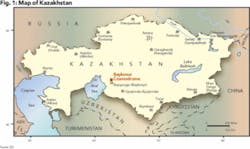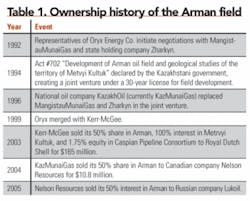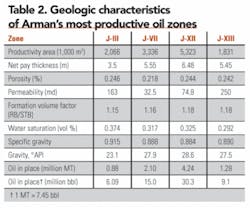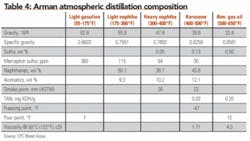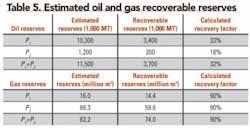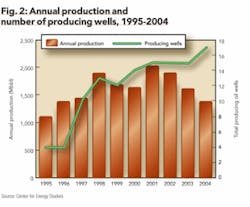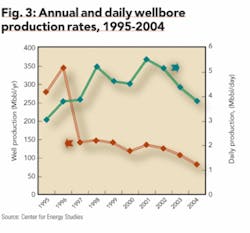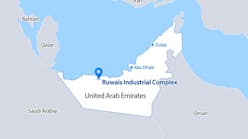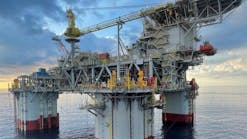Part 1: Geology and field development - Financial economics of the Arman oil field in Kazakhstan
EDITOR’S NOTE: This article provides an operational and economic assessment of a small onshore oil field in Kazakhstan. The Arman field in western Kazakhstan is estimated to hold recoverable reserves of 3.65 million metric tons of oil and 74 million cubic meters of gas. The field began production in 1994 as a joint venture between Oryx Energy, MangistauMunaiGas, and Zharkyn (the state holding company), and currently is operated by Royal Dutch Shell in a 50:50 joint venture with Lukoil. In part 1 of this two-part article, we review the ownership history of the joint venture and summarize the geology, crude composition, and field development.
Kazakhstan is a large, remote, and sparsely populated region that has historically served as a crossroads and land bridge between Europe and Asia (Fig. 1). Nearly four times the size of Texas, Kazakhstan has significant oil and gas reserves and abundant mineral resources. The first commercial discovery in West Kazakhstan was made in the South Emba area in 1911, and by 1970, more than 100 fields had been discovered in the suprasalt sequence, primarily in Jurassic and Cretaceous sandstone reservoirs (Votsalevsky 1999, Ulmishek, 2001). Proven oil and gas reserves are estimated at 39.6 billion barrels (Bbbl) oil and 105.9 trillion cubic feet (tcf) natural gas, roughly 3.3% and 1.7% of the world’s total proved reserves, respectively (BP 2006).
The petroleum industry plays an important role in the health of the economy and continues to develop rapidly. Real gross domestic product (GDP) growth has averaged about 10% a year since 2000, with rapid expansion in the construction and service sector. Per capita income has tripled during this time, and increasing oil production and the rise in world oil prices have translated into higher export earnings. In 2005, oil revenue accounted for about 11% of GDP and 63% total annual export revenues. Rising oil revenues have led to widening fiscal surpluses and lower public debt. Investment in the exploration and production sector in 2004 was $4.6 billion ($869 million in exploration and $3.7 billion in production) and, over the next decade, it is estimated that between $4 to $5 billion will be invested annually in the sector (International Monetary Fund 2004).
Considered a moderate, pro-Western, secular Muslim state, Kazakhstan continues to have high levels of bureaucracy and persistent corruption. Over the past two years, similar to trends elsewhere in the world, changes in Kazakhstan’s petroleum laws have considerably strengthened the state’s control of large enterprises with foreign investors. China and Russia are playing increasingly important roles in the energy development of the country due to their geographic proximity and historical ties.
Drawn to Russia because of shared borders, history, and a large minority of Russians in the north of the country (Stulberg, 2005), several hydrocarbon fields on the boundaries of the two countries are being jointly explored and developed. Kazakhstan also has growing investment and geopolitical ties with China, which acts to balance Russian influence while providing an alternative market and export route for its hydrocarbons.
Ownership history
The Arman oil field was discovered in 1979 in the North Caspian basin after geological studies to delineate the Kalamkas field indicated the presence of a new structure. After Kazakhstan’s independence in 1991, representatives of Oryx Energy Co. began negotiation for the exploration and production rights of the field (Table 1).
In 1994, the Kazakhstan government declared Act #702 “Development of Arman oil field and geological studies of the territory of Metvyi Kultuk”. This act created a joint venture (JV) between MangistauMunaiGas, Zharkyn, and Oryx and instructed the Ministry of Geology and Environmental Protection to issue a 30-year license for field development. The $3.9 million initial capital investment was shared between Oryx in the form of cash investments and by the Kazakhstani side in the form of geological studies, existing field infrastructure, buildings, and equipment.
In 1996, the national oil company, KazakhOil (currently KazMunaiGas), replaced MangistauMunaiGas and Zharkyn, and in 1999, Oryx merged with Kerr-McGee. Kerr-McGee sold its 50% share in the Arman JV in 2003, 100% interest in Metrvyi Kultuk, and 1.75% equity in the Caspian Pipeline Consortium to Royal Dutch Shell for $165 million. In 2004, KazMunaiGas sold its 50% interest in Arman to the Canadian company, Nelson Resources, for $10.8 million. In 2005, Nelson Resources sold its interest to the Russian company, Lukoil. Currently, Arman is operated by Royal Dutch Shell in a 50:50 arrangement with Lukoil.
Arman field geology
The Arman field is located near the Kalamkas and North Buzachi fields near the northwestern part of the Buzachi peninsula in a plain sloping towards the Caspian Sea. The area surrounding the Arman field has a semi-arid continental climate with hot summers (35-45°C) and cold, windy winters (-30°C).
Oil and gas reserves belong to the Jurassic stratum, similar to the Kalamkas field, but more broadly defined. Reservoir rocks are continental to Jurassic sandstones with low to moderate porosity in the range 18-28% and permeability in the range 32.5-250 md. The sandstones are laterally discontinuous. In Kalamkas, productivity was proved in 7 zones of the upper part of the geological section; in Arman, the lower part of the section also proved to be productive. Fourteen hydrocarbon zones have been identified: 9 oil zones (J-II - J-III, J-VIII - J-XIV), 2 oil and gas zones (J-VI, J-VII), and 2 gas zones (J-IV, J-V).
Reservoir characteristics
A summary of the geologic characteristics of the most productive oil zones are shown in Table 2. Geometric characteristics, including drainage areas, thickness, and estimated volumes, together with physical characteristics, including formation volume factor and water saturation, are also shown. For comparison with South Caspian oil fields see Bagirov et al. (1999).
Assay and composition
Arman crude is a heavy oil with 28.8° API gravity and a sulfur content of 0.99% by weight. Nickel and vanadium are present in small quantities (Table 3). High paraffin is a common phenomenon in the region (Zettlitzer, 2000), but the paraffin content of Arman (UOP-Watson characterization factor K=12.1) does not pose any transportation problems. The distillation fraction percentages UX of the crude, where UX denotes the fraction content at X°F, are U300 = 9.58%, U500 = 26.2%, U650 = 41.5%, U800 = 59.4%, U1050 = 77.25%. Table 4 depicts the composition of the atmospheric cuts.
Reserves
The total proven and probable oil reserves at Arman are estimated to be 11.5 million metric tons (MT), of which about 32% (3.65 million MT of oil) are estimated to be recoverable (Table 5). The total proven and probable gas reserves are estimated to be 82 million cubic meters, of which 90% (or about 74 million cubic meters) are expected to be recoverable (Table 5). Recoverable reserves estimates exist under a wide band of uncertainty because many variables outside geoscience and reservoir engineering end up being captured in the recovery factor (Caldwell and Heather, 2001).
Field development and production history
Development schemes vary widely across the world, and even in different areas within the same region, depending upon: the size, shape, depth, and productivity of the reservoir; the time of development and proximity to infrastructure; logistical considerations in moving the production to market; operating conditions; economic considerations; strategic decisions and lead time required to acquire or design and construct rigs, production facilities, pipelines, and other downstream facilities.
In 1995, 3 test wells and one production well were drilled at Arman to a depth of 1,300 m. By 2004, 17 producing wells were extracting 1.4 million barrels at an average wellbore production rate of 3,820 bbl per day (Figures 2, 3). Since 2001, the decline rate in the field has averaged 11.5%. About 60% of Arman’s recoverable reserves have been extracted.
Reservoir pressure
A reservoir is pressurized because of its location, trap, and rock characteristics, and other factors. As oil is produced, the reservoir pressure decreases, leading to a drop in the driving force and oil production. As pressure declines and eventually dissipates, oil will no longer flow to the surface naturally, and must be pumped using artificial lift or abandoned. The first water injection well at Arman was drilled in 1998. Currently, reservoir pressure is maintained by 7 injection wells, which in 2004 consumed an average of 490 cubic meters of water per day per injection well.
Processing
Oil is prepared in several stages. Emulsified crude oil is treated with a demulsifying agent, heated to 45-48ºC, and then sent to separation tanks. Crude with water content less than 5% is heated to 60ºC where it flows to a separator and settling tank. Crude with water content less than 1% is sent to an electric dehydration unit, cleaned from chloride salts, and then sent to a final processing stage where additional water and salt is removed.
Associated gas is utilized for oil heaters, power generation, and water flooding; the remaining gas is flared. In 2005, the government issued a legislative act prohibiting gas flaring, but for select old contracts, including the Arman JV, the effective date of the act was delayed to 2006.
Arman currently processes about 1,400 MT/day of oil from the North Buzachi field. A capital investment program is underway to de-bottleneck existing facilities to increase capacity to handle more Buzachi crude.
Transportation
Before 2003, Arman crude was transported by pipeline 10 km to the Uzhnefteprovod trunk line, mixed with Kalamkas production, pumped south to Karazhanbas, and then onward to the port of Aktau for export. From 2003, Arman production has been transported through the Caspian Pipeline Consortium (CPC) via Atyrau. The CPC was constructed to export oil from the Tengiz and Korolev fields to Novorossiysk on the Black Sea.
CPC began operating in October 2001, with access rights, pumping privileges, and tariffs contained in a schedule described in the founding documents. Royal Dutch Shell and LukARCO maintain ownership equity in CPC, which allows transportation tariffs for Arman production to be set with a discount.
This case study of the Arman oil field concludes next month with Part 2: Operational and Profitability Assessment.
About the authors
Mark J. Kaiser [[email protected]] is a research professor at the Center for Energy Studies at Louisiana State University in Baton Rouge, La. His primary research interests are related to policy issues, modeling, and econometric studies in the oil and gas industry. Prior to joining LSU in 2001, he held appointments at Auburn University, the American University of Armenia, and Wichita State University. Dr. Kaiser holds a PhD from Purdue University.
Anar Kubekpayeva is with the Kazakhstan Institute of Management, Economic and Strategic Research, Bang College of Business, Almaty, Kazakhstan.
